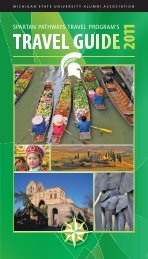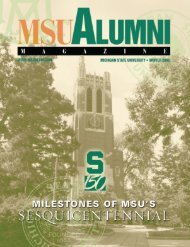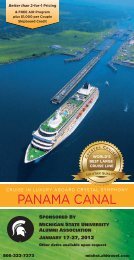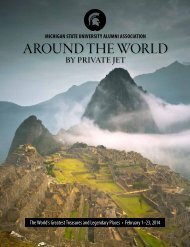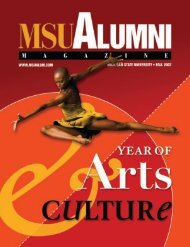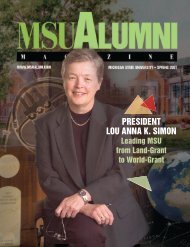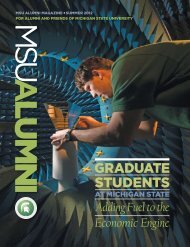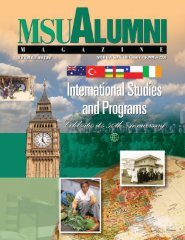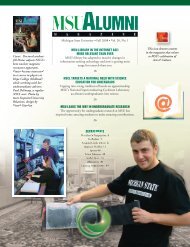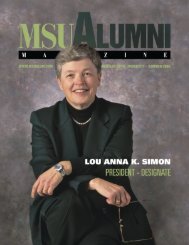mark dantonio - MSU Alumni Association - Michigan State University
mark dantonio - MSU Alumni Association - Michigan State University
mark dantonio - MSU Alumni Association - Michigan State University
Create successful ePaper yourself
Turn your PDF publications into a flip-book with our unique Google optimized e-Paper software.
license agreements for new technologies<br />
and systems.<br />
“Our research universities are<br />
creators of knowledge and generate<br />
the innovations, new technologies<br />
and new businesses that<br />
not only provide jobs, but also<br />
improve the life for all citizens of<br />
<strong>Michigan</strong>,” says <strong>MSU</strong> President<br />
Lou Anna K. Simon.<br />
Detroit News columnist Dan<br />
Howes calls it “the closest thing<br />
<strong>Michigan</strong> has to Silicon Valley—<br />
an intellectual powerhouse.”<br />
<strong>MSU</strong> NO. 1 IN STUDY ABROAD<br />
For the second straight year,<br />
<strong>MSU</strong> is the top public university<br />
in the U.S. for study abroad, according<br />
to Open Doors 2006,<br />
the annual report by the Institute<br />
of International Education.<br />
In 2004-2005, 2,385 <strong>MSU</strong> students<br />
studied abroad, second only<br />
to New York <strong>University</strong> among<br />
all colleges and universities.<br />
Kathleen Fairfax, director of<br />
<strong>MSU</strong>’s Office of Study Abroad,<br />
touts “both the strength of <strong>MSU</strong>’s<br />
institutional commitment to study<br />
abroad as well as the depth and<br />
breadth of faculty involvement.”<br />
<strong>MSU</strong> offers among the most<br />
diverse study abroad options,<br />
with more than 230 programs<br />
in 62 countries on all continents—including<br />
Antarctica.<br />
<strong>MSU</strong> was one of five universities<br />
highlighted in a November report<br />
by NAFSA: <strong>Association</strong> of International<br />
Educators as 2006 winners<br />
of the Paul Simon Award For<br />
Campus Internationalization.<br />
LAW COLLEGE TOPS IN STATE<br />
The <strong>MSU</strong> College of Law<br />
achieved the highest pass rate<br />
on the July 2006 <strong>Michigan</strong> Bar<br />
Exam among public institutions<br />
in the state.<br />
<strong>MSU</strong> had 180 first-time test<br />
takers and they achieved a 94<br />
percent pass rate, compared to<br />
the state average of 91 percent.<br />
Tied for second place—at 93<br />
percent—were Wayne <strong>State</strong> <strong>University</strong>,<br />
with 162 first-time takers,<br />
and the <strong>University</strong> of <strong>Michigan</strong>,<br />
with 30 first-time takers. Only<br />
Ave Maria School of Law, a<br />
private Catholic law school, had<br />
graduates pass the bar at a higher<br />
rate; 96 percent of its 26 firsttime<br />
takers passed.<br />
CROUCHING TIGER—<strong>MSU</strong>’s Kresge Art Museum has acquired this<br />
fabulous Chinese ceramic pillow, dated around 1160 AD in the Jin<br />
Dynasty. The <strong>MSU</strong> purchase was funded by the Emma Grace Holmes<br />
Endowment. In early Chinese mythology and art, the tiger was<br />
regarded as an auspicious guardian beast, noted for its bravery and<br />
nobility, explains museum director Susan Bandes. This pillow was<br />
probably intended to ward off evil spirits in the night.<br />
Pillow in the Form of a Recumbent Tiger, 1160 AD<br />
Photo courtesy of Kresge Art Museum<br />
A tradition begun to honor <strong>MSU</strong>’s Sesquicentennial, Fred<br />
Honhart, director of <strong>MSU</strong> Archives & Historical Collections, will<br />
continue to highlight key moments and people in <strong>MSU</strong> history.<br />
This year is the<br />
50th anniversary of<br />
our National Superconducting<br />
Cyclotron<br />
Laboratory (NSCL).<br />
How <strong>MSU</strong> came to<br />
acquire the NSCL<br />
began in the 1950s,<br />
when <strong>MSU</strong>’s physics<br />
department wanted to<br />
enter the field of high<br />
energy physics. Under<br />
the leadership of professor<br />
Joseph Ballam,<br />
a committee decided<br />
that <strong>MSU</strong> should<br />
build a state-of-the-art<br />
cyclotron.<br />
Milton Muelder,<br />
then dean of arts and science, and<br />
later vice-president for research,<br />
enlisted the support of President<br />
John A. Hannah. Muelder<br />
enticed Sherwood Haynes from<br />
Vanderbilt <strong>University</strong> to be the<br />
new department chair. Haynes<br />
hired Henry Blosser, then at<br />
the Oak Ridge nuclear facility,<br />
to head up the <strong>MSU</strong> cyclotron<br />
research project. Blosser has<br />
since noted that <strong>MSU</strong>’s MISTIC<br />
computer (see “MISTIC Memories,”<br />
Fall 2006, p. 57), which<br />
was similar to one they used at<br />
Oak Ridge, influenced his decision<br />
to come to <strong>MSU</strong>. He and<br />
Muelder sought funding for the<br />
project from the Atomic Energy<br />
Commission (now the Dept. of<br />
Energy). At one point President<br />
Hannah told Muelder if they<br />
could not get funding <strong>MSU</strong><br />
would build its own high energy<br />
cyclotron.<br />
Henry Blosser<br />
Harley Seeley/IMC<br />
In various trips to Washington,<br />
D.C., Muelder and Blosser<br />
met with Glenn Seaborg, the<br />
head of the Atomic Energy<br />
Commission. He was intrigued<br />
by the <strong>MSU</strong> efforts and his<br />
support helped secure the<br />
project’s first National Science<br />
Foundation Grant—$700,000<br />
for a 50 MEV cyclotron at<br />
<strong>MSU</strong>. <strong>MSU</strong> would build the<br />
building housing it. Thus<br />
<strong>MSU</strong> began to develop one of<br />
the preeminent high energy<br />
nuclear research facilities in the<br />
world.<br />
In 1989, Sam Austin succeeded<br />
Blosser as NSCL director<br />
and in 1992 and he was<br />
succeeded by Konrad Gelbke.<br />
With the most recent $100<br />
million grant, Gelbke and his<br />
faculty are ready to move vigorously<br />
forward with the next half<br />
century of high energy physics<br />
research at <strong>MSU</strong>.<br />
Click Right Through for <strong>MSU</strong><br />
www.msualum.com<br />
Page 5<br />
046957070001_04-9.indd 5<br />
2/2/07 1:02:19 PM




